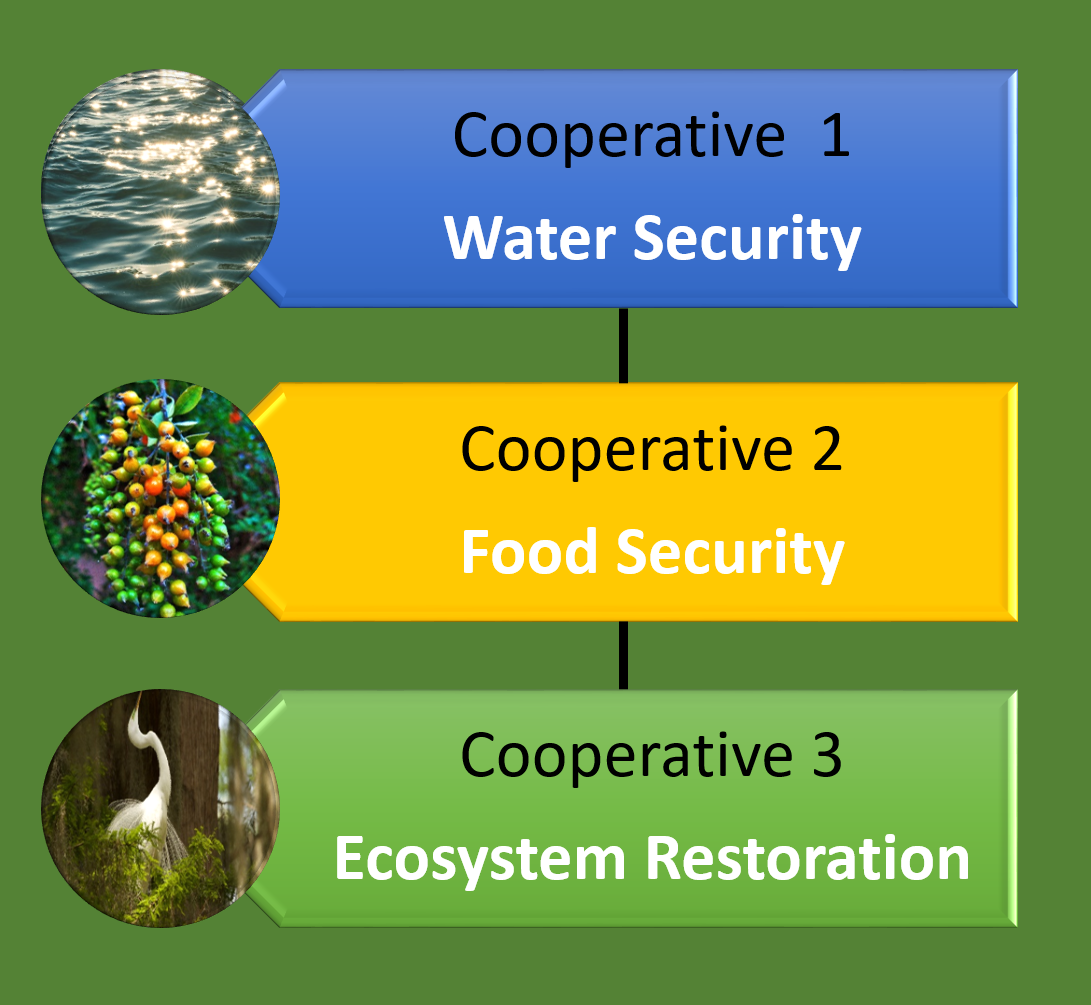Our System
Reap Goodness Training: Trios of Cooperatives
This system is unique in the world. It brings together cooperatives in a set of 3 to work in harmony. Based on the needs of their local community, the 3 cooperatives will make a mutual agreement to work either individually or jointly. With the right training to guide them, these sets of 3 cooperatives (we’ll call them Trios going forward) can form anywhere in the world, at any time. This training is what Reap Goodness provides.
On this page, we will explain just how the system will work in your community to secure food and clean water, restore Earth, and ensure ample prosperity of life for all beings who live there and want to thrive.
3 cooperatives work together or separately as needed locally
Water Security Cooperative
Community Benefits
Rain Storage
Land is a huge sponge. It can store water. Ditches are dug on slopes, allowing rain water to seep into Earth’s giant sponge, stored there for use later when people dig wells. People can also dig ditches to direct water to ponds. These projects can be done even in deserts.
Rain Capture
We can capture rainwater when it slides down roofs, and catch it in troughs that direct the water into a tank, where it is filtered and used when needed.
Solar panel arrays on legs that are on a slant can also allow rain to slide down and be captured into a tank in the same way. The water can also be directed from the solar panels into a pond for later use.
Teach Systems
The rain capture and storage systems are easy to learn, harder to do. The cooperatives that do this can teach the techniques in local schools as part of their classes or an extracurricular activity or at town hall meetings. This way, students can teach their parents and other people in the community how to have water security forever.
Food Security Cooperative
Community + Region Benefit
Food Forestry
We plant perennial foods that do not need annual planting to imitate what we find in a natural forest – fruit and nut trees, berry bushes, edible shrubs, vegetables, herbs, root foods, and climbing vines that grow up the trees, like grapes. We plan, plant, and nurture them using water from the swales and ponds.
Food Preservation
The food savvy cooperative can also preserve excess fresh food. This includes gentle drying, quicker fermentation, or pickling of certain foods in reusable containers.
These foods can be saved for off-season when they are not available fresh from the ground. All these foods will be raised and preserved organically.
Combination with Annual Crops
While food forests can provide all we need, it takes a while for them to get established. In the meantime, as well as going forward, we can combine them with annual crops that we are all familiar with and love to eat. The variety of foods like the ones from grocery stores can be planted next to a food forest. And when the food forest is established, we will be able to harvest foods from both annual and perennial plants.
Ecosystem Restoration Cooperative
Community and World Benefit
Water Pollution Mitigation
Here we see water cleansing plants pulling pollution out of rivers and ponds. Once done, ecosystems are restored. By adding select soil microbes into these waters, they are cleansed even further. Mulching around nearby plants prevents soil runoff into the rivers and ponds, restoring their balance in nature. Mulching also keeps moisture and carbon capture in the soil around those plants.
Increase Animal Protection
This dignified activity begins with planning for animal sanctuaries away from farming for animal safety and privacy. Providing clean ponds is a lifesaving activity for animals of all sizes. Roadside ditches worldwide will be planted with water cleansing plants. In addition, plants that support tiny pollinators will be planted in sanctuaries as well as the roadside ditches.
Nutrient Emphasis
Those who do the planting of food in this cooperative will research the nutrition needed by the local populations – both people and animals. With this information of high nutrient crops, the food co-op will serve as an advisory team for the other cooperatives in the trio.
They will also plant those plants with the highest nutritional density for animals in the sanctuaries nearby, thus mitigating animal extinctions.
Comprehensive Solution
Reap Goodness’ unique business model and approach involves the bringing together of local people to form not one, but three worker cooperatives to work either together or separately, depending on their mutual agreement, to change the landscape from desertified dirt to vibrant soil, teeming with life and prosperity.
Each cooperative will play a different role. The first will store water in land with water catchment ditches and from roofs during rains. The second one will plan, plant and harvest food forests for local residents. The third will clean polluted waters in roadside ditches, streams and ponds for both people and wildlife sanctuaries.
Working together arm in arm or separately, these cooperative trios will transform the planet in the wink of an eye.




